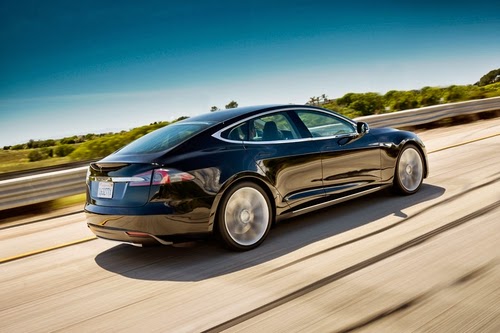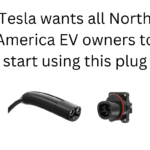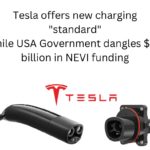With
the Model S launch around the corner, the EPA released the official
ratings today, confirming the numbers Tesla published last month, unless
ones mind remembered the other, much higher, range rating claimed by
Tesla.
With
the impending official launch of the Tesla Model S, the EPA released
its official ratings of that electric car. The ratings fall in line
with the estimates Tesla published over a month ago, and validate that
Tesla achieved its range and efficiency goals for the Model S. With the
EPA ratings in hand we can now compare the Model S to other all
electric luxury cars, if there were any.
The EPA ratings were released for the regular version of the Model S,
with a base price of $77,400. It has an 85 kilowatt-hour battery pack,
does 0-60 in 5.6 seconds, a top speed of over 120 miles/hr, and begins
shipping this summer following the 1,000 Signature series cars.
The official EPA ratings are: 89 miles/gallon equivalent (combined),
88 MPGe (city) and 90 MPGe (highway), based on consuming 38 kilowatt
hours per 100 miles (combined). The cost to drive 25 miles is $1.25,
and the EPA forsees an annual fuel cost of $700. The official EPA
driving range is 265 miles, and will take 12 hours to recharge at 240
volts.
The efficiency of the Model S is in line with the other electric
cars. The Coda electric car has a 73 MPGe (46 kilowatt hours / 100
miles), the Nissan Leaf has an 99 MPGe (34 kilowatt hours / 100 miles),
the Ford Focus Electric has a 105 MPGe (32 kilowatt hours / 100 miles),
the Mitsubishi i-MiEV as a 112 MPGe (30 kilowatt hours / 100 miles), and
the Honda Fit EV has a 118 MPGe (29 kilowatt hours / 100 miles).
The charging time reported by the EPA requires a much longer time
than the other electric cars, because of the relatively huge battery
pack. The 85 kilowatt hour battery pack, when charged at a 10 kilowatt
rate supported, would require at least 9 hours of charging and could
well add up to 12 hours for a complete recharge from 0. This will make
the Twin Chargers, supporting a 20 kilowatt charging rate, a nice option
for reducing the charging time. On the other hand, if you’re out and
about using public charging stations, you’ll be unlikely to get more
than a 7 kilowatt charging rate (240 volts, 30 amps, is 7.2 kilowatts).
For contrast, the Nissan Leaf, with a 24 kilowatt-hour battery pack,
requires 7 hours to recharge, with its built in 3.3 kilowatt charger.
What may be a head-scratcher for some is that Tesla claimed the Model S has a 320 mile driving range![]() ,
,
while the official EPA rating is 265 miles driving range. We predict
that some will have skipped over the details Tesla published at that
time, and start complaining about Tesla inflating their range estimates,
when in fact Tesla also predicted a 265 mile driving range.
What’s going on, and Tesla explained this at the time, is there are
two procedures used by the EPA to estimate the driving range. The old
procedure (2 cycle), and the new 5-cycle test procedure. The old
procedure is carried out at a 75 degrees Fahrenheit ambient temperature,
with varying speeds and accelerations at speeds up to 60 miles/hr. The
old test isn’t very representative of the real world usage patterns,
and the EPA is instituting the new 5-cycle test procedure. That test
has more test cycles, and pushes the vehicle harder, including both
cold- and hot-weather testing. It’s thought to be a more realistic test
procedure.
It was under the 2-cycle EPA test which the Tesla Model S scored a
320 mile range. Under the new 5-cycle EPA test, the Tesla Model S now
scores a 265 mile range. Tesla accurately predicted the EPA rated 265
mile driving range at that time.
The 260 kilowatt electric motor on the Tesla Model S is over twice as
powerful as the other electric cars (66 kilowatts for the iMiEV, 80
kilowatts for the Leaf, 100 kilowatts for the Coda, and 107 kilowatts
for the Ford Focus Electric), which is part of why the Model S has such
blistering fast 0-60 times. This is also why the 320 miles range (at 60
miles/hr) Tesla claimed last month was unlikely to ever be met, because
who could ever drive such a fast car at such a sedate speed for such a
long distance?
– See more at:
http://www.torquenews.com/1075/tesla-model-s-has-265-miles-electric-range-89-mpge-official-epa-ratings
- Highway design could decrease death and injury risk, if “we” chose smarter designs - March 28, 2015
- GM really did trademark “range anxiety”, only later to abandon that mark - March 25, 2015
- US Government releases new regulations on hydraulic fracturing, that some call “toothless” - March 20, 2015
- Tesla Motors magic pill to solve range anxiety doesn’t quite instill range confidence - March 19, 2015
- Update on Galena IL oil train – 21 cars involved, which were the supposedly safer CP1232 design - March 7, 2015
- Another oil bomb train – why are they shipping crude oil by train? – Symptoms of fossil fuel addiction - March 6, 2015
- Chevron relinquishes fracking in Romania, as part of broader pull-out from Eastern European fracking operations - February 22, 2015
- Answer anti- electric car articles with truth and pride – truth outshines all distortions - February 19, 2015
- Apple taking big risk on developing a car? Please, Apple, don’t go there! - February 16, 2015
- Toyota, Nissan, Honda working on Japanese fuel cell infrastructure for Japanese government - February 12, 2015












